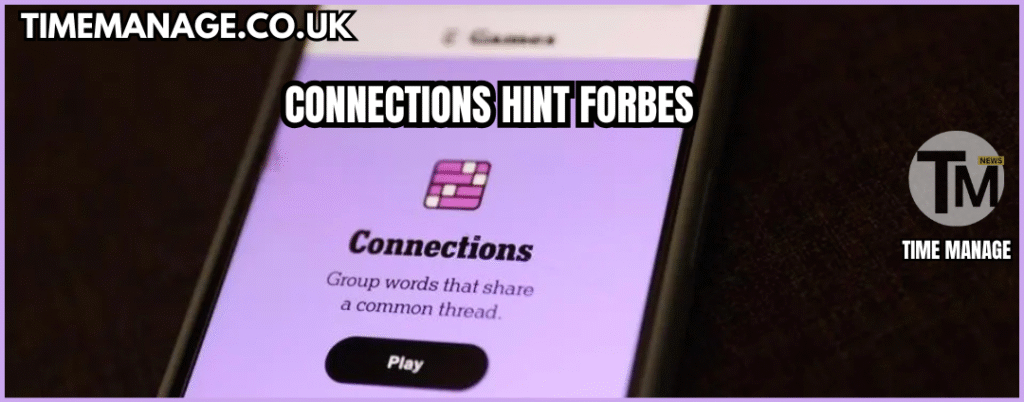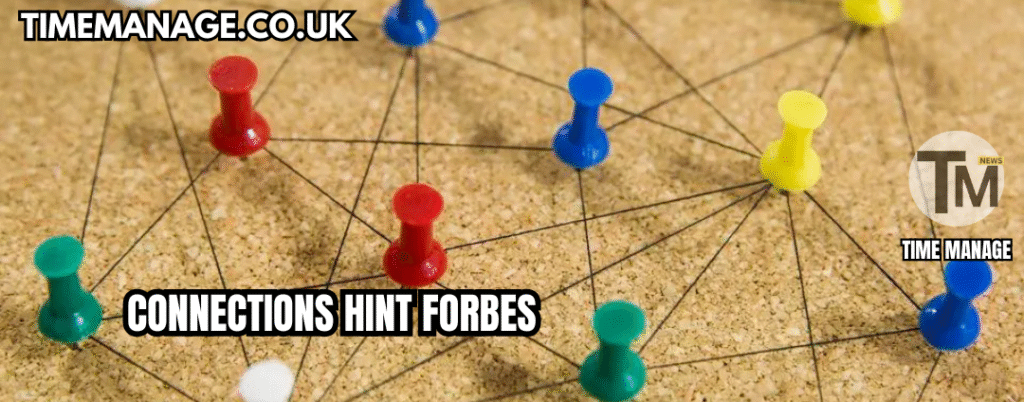If you play The New York Times Connections puzzle every morning, chances are you’ve searched for clues when you get stuck. That’s where the term “Connections Hint Forbes” comes in. Forbes has become one of the most popular sources for daily hints and answers to the NYT Connections puzzle.
In this guide, we’ll explore what the Connections puzzle is, how Forbes provides hints, why players rely on them, and how to use those hints wisely without spoiling the fun. We’ll also share strategies to improve your puzzle-solving skills and answer the five most common questions about “Connections Hint Forbes.”
What Is the NYT Connections Hint Forbes Game?
NYT Connections Hint Forbes is a daily word puzzle created by The New York Times. It challenges your ability to find common themes among seemingly unrelated words. Each puzzle contains 16 words, and players must divide them into four groups of four words that share a hidden connection.
For example:
- Group 1: Banana, Rainbow, Eyebrow, Arch → All arc-shaped
- Group 2: Lion, Bear, Toucan, Tiger → All cereal mascots
- Group 3: Asterisk, Number, Dagger, Parentheses → All symbols used in text
Once you find the connections correctly, you win! However, the tricky part is that some words fit into multiple possible groups, which often confuses even experienced players.
That’s why many turn to websites like Forbes, which publishes daily hints and explanations for each puzzle.
What Does “Connections Hint Forbes” Mean?
When players search “Connections Hint Forbes,” they’re usually looking for the Forbes daily article that offers hints for the NYT Connections puzzle.
Each day, Forbes posts an article such as:
“NYT Connections Hints and Answers for [Date]: Clues to Today’s Puzzle”
These articles are typically written by Kris Holt, a Forbes contributor who covers daily puzzles like Connections, Wordle, and Strands.
Here’s What Connections Hint Forbes Typically Includes in Their Connections Hint Article:
- An Overview
A quick summary of how to play the game and a short introduction for new players. - The Daily Word List
The 16 words from that day’s puzzle, often in a grid format. - Hints for Each Group
Forbes offers subtle clues such as:
- Yellow group hint: “Show off.”
- Green group hint: “Arc-shaped things.”
- Blue group hint: “Cereal mascots.”
- Purple group hint: “Typographical symbols.”
- Yellow group hint: “Show off.”
- Spoiler Warning
Before revealing the full answers, Forbes always includes a spoiler alert, allowing players to stop reading if they want to keep solving. - Full Answers and Group Themes
After the warning, Forbes lists all the correct groups with their answers and explains each connection. - Author Commentary
Some articles end with brief analysis or insights into the puzzle’s logic.
This structure makes Forbes one of the most reliable sources for NYT Connections help online.
Why Do Players Trust Connections Hint Forbes?

There are many websites and Reddit threads that post Connections Hint Forbes. So why is Forbes so popular? Here’s why:
1. Accuracy and Reliability
Forbes has professional contributors who cross-check their answers. You can trust that the hints and solutions are correct.
2. Early Posting Times
The hints often go live early in the day, sometimes within hours of the puzzle’s release.
3. Gradual Hint Style
The clues progress from light nudges to complete answers. That means you can stop reading once you’ve got enough of a push.
4. Free and Accessible
Unlike some puzzle blogs, Forbes’s hints are free to read, making them accessible to all players.
5. Easy Navigation
Forbes archives all past hints by date, so if you missed a puzzle or want to revisit one, it’s simple to find previous solutions by searching “Forbes Connections [date].”
How to Use Forbes Hints Without Spoiling the Puzzle
Using hints can be a double-edged sword. They’re helpful, but they can also remove the satisfaction of solving on your own. Here’s how to use Forbes hints wisely:
Step 1: Try the Puzzle First
Before searching for hints, give yourself at least 10–15 minutes to think through possible connections.
Step 2: Read Only the Light Hints
Start with the general group hints — for example, “arc-shaped things” — without scrolling to the answers.
Step 3: Use the Hints as Anchors
Once you recognize one group, it becomes easier to find the rest by process of elimination.
Step 4: Stop Before the Answers
When Forbes warns you about spoilers, stop reading unless you’re completely stuck.
Step 5: Review After Solving
After finishing, look at Forbes’s full explanations. This helps you learn how the creators think and improves your pattern recognition.
Example: How Forbes Hints Work in Practice
Let’s walk through a real example using a past Connections Hint Forbes” article.
From June 11, 2025, Forbes published hints for the day’s puzzle:
Word List:
Banana, Eyebrow, Rainbow, Flight Path, Count, Leprechaun, Rooster, Elves, Bluster, Crow, Strut, Show Off, Number, Dagger, Asterisk, Parentheses
Hints:
- Yellow group hint: Brag
- Green group hint: Arc-shaped things
- Blue group hint: Cereal mascots
- Purple group hint: Typography symbols
If you stopped after reading those hints, you could likely solve most of the puzzle on your own.
But if you needed the full answers, Forbes listed them later as:
- Yellow (Brag): Bluster, Crow, Show Off, Strut
- Green (Arc-shaped): Banana, Eyebrow, Flight Path, Rainbow
- Blue (Cereal Mascots): Count, Elves, Leprechaun, Rooster
- Purple (Typography Symbols): Asterisk, Dagger, Number, Parentheses
That’s how Forbes balances helpful clues with clear formatting — so readers can choose how much help they want.
Tips to Get Better at NYT Connections
While hints are useful, the goal is to get better at the game itself. Here are some proven strategies from experienced solvers and puzzle experts:
1. Look for Obvious Themes First
Find the words that clearly fit together — like colors, animals, or sports terms — before worrying about trickier groups.
2. Watch Out for Double Meanings
Many puzzles use words that can mean multiple things. For example, “Plant” could mean a flower or an undercover agent.
3. Eliminate Step by Step
Once you’ve confirmed one correct group, the rest becomes easier to deduce by removing those words from consideration.
4. Learn Common Connection Types
The NYT often reuses certain themes, like:
- Colors
- Musical instruments
- Idioms
- Food items
- Movie titles
- Body parts
Recognizing these patterns gives you a head start.
5. Think Outside the Box
Sometimes connections aren’t literal — they’re cultural, idiomatic, or symbolic. That’s what makes Connections so engaging.
6. Practice Daily
The more puzzles you solve, the easier it becomes to spot connections instantly.
How Forbes Articles Can Help Improve Your Skills
Even if you don’t use the hints directly, reading Forbes’s explanations can sharpen your understanding. Here’s how:
- You learn how the puzzle creators think when designing groups.
- You start recognizing recurring logic patterns (e.g., wordplay, homonyms).
- You build a mental database of themes (like “types of arcs,” “movie genres,” “phrases with time”).
- You get to see why wrong answers seemed right, improving your deduction skills.
Over time, you’ll notice that you need fewer hints — and that’s a great feeling.
Is It Ethical to Use Hints?
Some purists argue that using hints takes away from the puzzle’s spirit. However, most players see it differently.
Using hints doesn’t mean cheating — it’s just another way to engage with the game. Think of it as learning how to think like the puzzle maker. In fact, many Forbes readers say that reading the hints after solving helps them appreciate the game’s design more.
As long as you’re not spoiling the answer for others or relying on full reveals every day, using “Connections Hint Forbes” responsibly can enhance your experience.
How to Find Connections Hint Forbes Quickly

You can find Forbes’s latest Connections Hint Forbes easily by searching:
- “Connections Hint Forbes [today’s date]”
- “Forbes NYT Connections clues and answers”
- Or simply visit forbes.com/sites/krisholt/ for the daily updates.
Bookmarking the page helps if you play every morning.
SEO Perspective: Why “Connections Hint Forbes” Ranks Well
From an SEO standpoint, “Connections Hint Forbes” ranks highly because it combines a trending daily keyword (Connections) with a trusted publication (Forbes).
For bloggers or site owners, writing content around this topic can be highly effective. You can cover:
- Daily summaries of Forbes hints
- Strategy guides
- Puzzle breakdowns
- Analysis of common NYT themes
Including keywords like “NYT Connections Hint Forbes Connections clues,” and “Connections answers today” helps attract organic traffic from puzzle enthusiasts.
5 Frequently Asked Questions About Connections Hint Forbes
1. What is “Connections Hint Forbes”?
“Connections Hint Forbes” refers to the daily articles Forbes publishes that include clues, hints, and answers for the NYT Connections word puzzle.
2. Who writes the Connections Hint Forbes?
Most of the Connections Hint Forbes articles are written by Kris Holt, a contributor who covers daily puzzles like Wordle, Strands, and Connections.
3. Are Forbes hints free to read?
Yes. All Connections Hint Forbes articles are free and accessible without a subscription. Just visit the Forbes website or search for the date you need.
4. Should I use hints before trying the puzzle?
It’s best to try solving the puzzle yourself first. Use Forbes hints only if you’re stuck or want to learn how to approach future puzzles.
5. Can I find hints for older puzzles on Forbes?
Yes, you can. Just search the date along with “Connections Hint Forbes” on Google (for example, “Forbes Connections July 15 hints”) to access archived posts.
Final Thoughts
The “Connections Hint Forbes” articles have become a daily ritual for thousands of puzzle fans around the world. They strike the perfect balance between helpful guidance and player independence — offering just enough clues to keep you engaged without spoiling the thrill of discovery.
Whether you’re a beginner or an expert solver, Forbes’s daily hints can help you learn faster, think smarter, and appreciate the complexity of NYT Connections puzzles.
Next time you’re stuck, remember: it’s not cheating — it’s just smart strategy. Check Forbes, get your hint, and then go make those connections!





